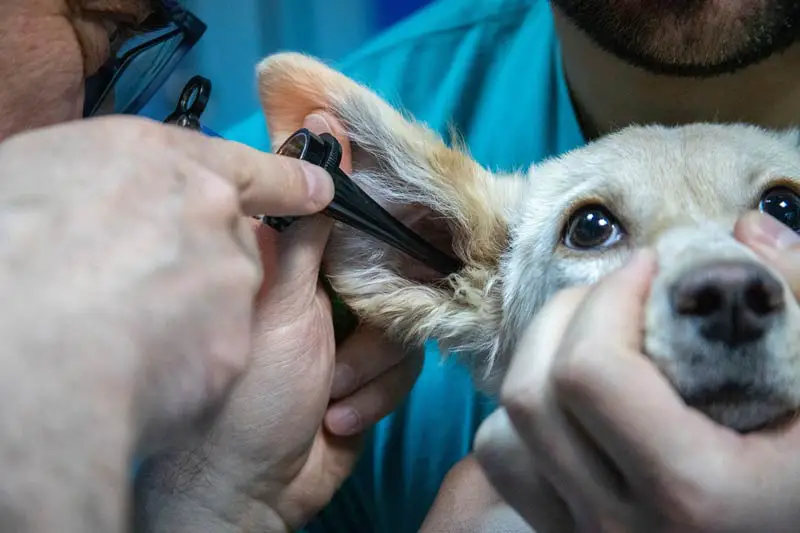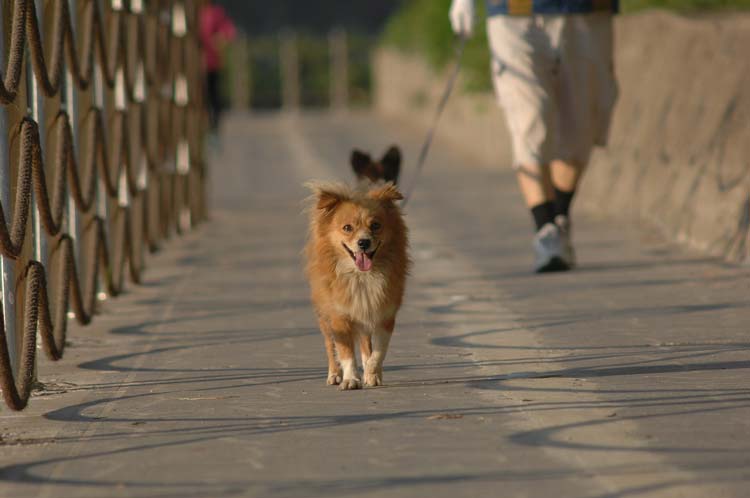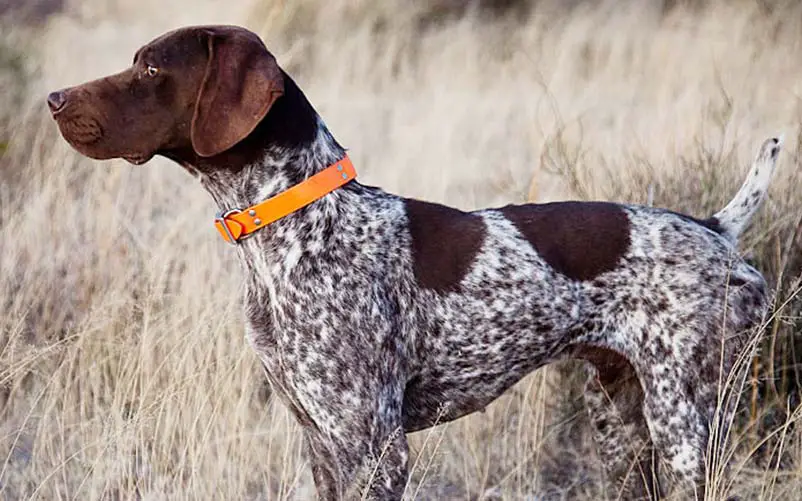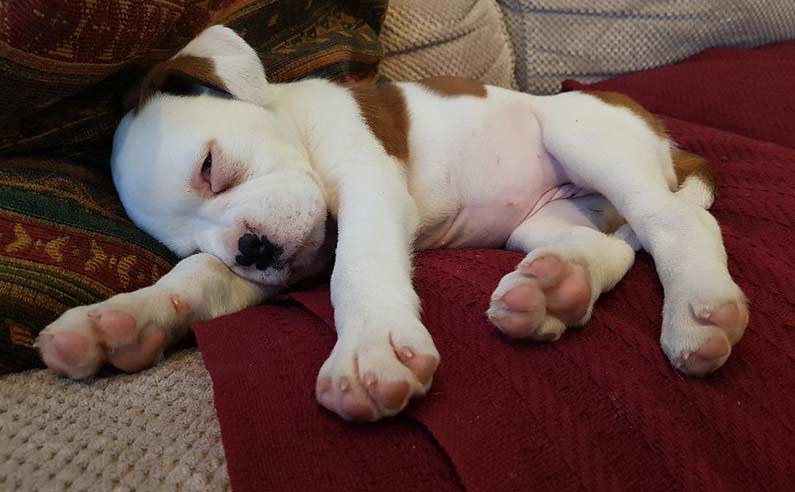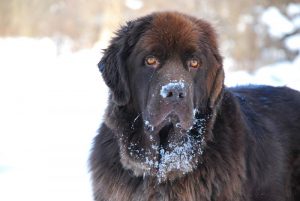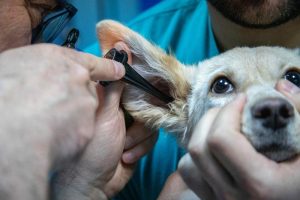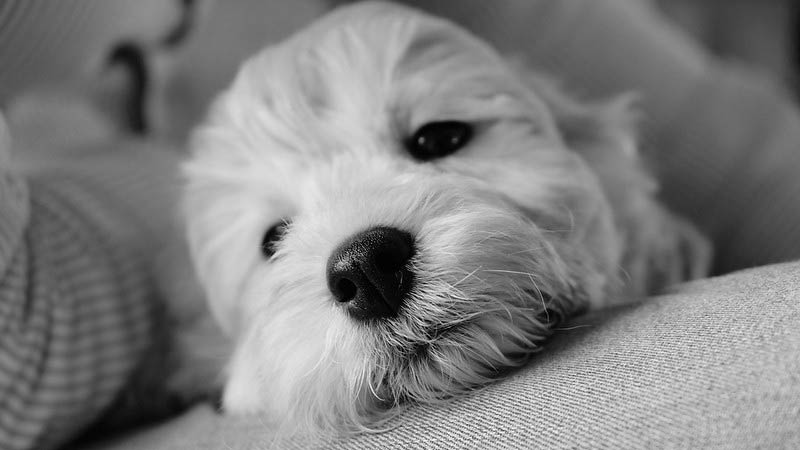
Page Contents
How big can a Maltipoo Get?
The general size of Maltipoo dogs is around 5 to 20 pounds in weight and 8 to 14 inches in height. With that said, it also depends on whether they are tiny/toy or medium/mini. So, how big can these different and specific versions of Maltipoo get? We have a chart below:
| Maltipoo Variation | Height (inches) | Weight (pounds) |
| Mini Maltipoo | 11 to 14 | 15 to 25 |
| Toy Maltipoo | 6 to 11 | 5 to 10 |
The medium and the tiny Maltipoo will likely have a height and weight that’s based around mini and toy Maltipoos, respectively. However, it still depends on a variety of factors, such as their genetics, food, and others.
Maltipoo Growth Chart – What to Expect
If you want to know what to expect on a Maltipoo from puppyhood to adulthood, here’s a guide to help you out. Knowing what to expect will prepare you for any kind of growth spurt or instance when you may need to change the dog’s diet and other routines.
See also:
| Age in Month | Weight in Kilograms | Weight in Pounds |
|---|---|---|
| 1 month | 0.3 - 0.8 (kg) | 0.7 - 2.7 (lbs) |
| 2 months | 0.8 - 2.8 (kg) | 1.9 - 6.2 (lbs) |
| 3 months | 1.1 - 4.5 (kg) | 2.5 - 10 (lbs) |
| 4 months | 1.5 - 5.8 (kg) | 3.5 - 13 (lbs) |
| 6 months | 1.9 -7.7 (kg) | 4.2 - 17 (lbs) |
| 8 months | 2.3 - 8.0 (kg) | 5.0 - 18 (lbs) |
| 10 months | 2.3 - 8.6 (kg) | 5.0 - 19 (lbs) |
| 12 months | 2.2 - 8.8 (kg) | 5.0 - 19.5 (lbs) |
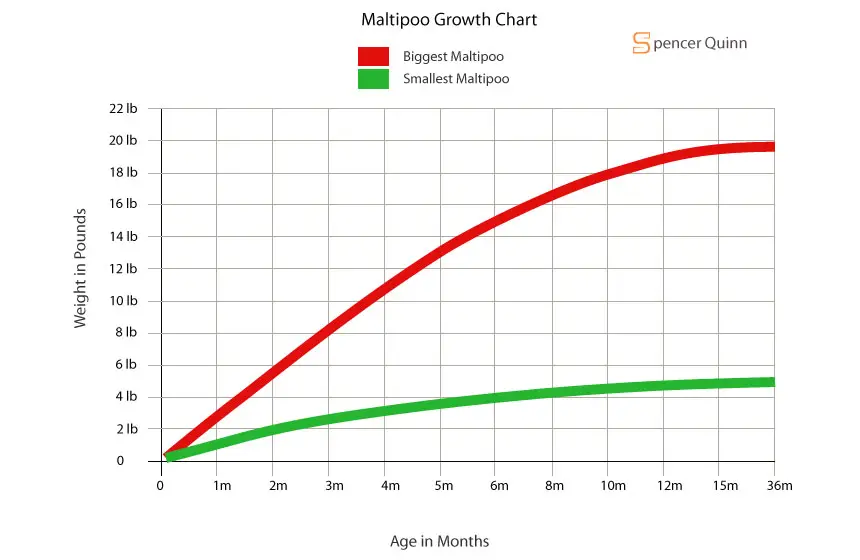
Newborn to 3 weeks
A newborn Maltipoo should be with their mother all the time to keep them warm and to be nursed. Like every puppy, they still have closed eyes during their first few weeks and they need to be cleaned by their mother by licking. It is also normal that the eyes might be opened through this process.
Maltipoo pups should be kept in a low-light environment so that they won’t risk getting eye problems in the future. Consider getting a safe spot with a nightlight that you can gradually increase once the puppies grow older.
During the puppies’ third week, they are likely to develop their hearing senses aside from sight. They might also make their first few walks and crawls during this time so you should let them explore but keep them safe and within the vicinity of their mother.
4-6 weeks
During their fourth week, a Maltipoo puppy can be slowly weaned. Keep in mind that weaning is a slow and steady process so it’s okay if your puppy doesn’t eat your food mixture at first – try offering the food in little amounts first to avoid wasting a lot.
You might also want to increase the amount of water on the food but be sure to take it out after 15 to 20 minutes of inactivity since it will spoil afterward – especially in a humid environment. Once your puppy is slowly trying out the mixture, gradually increase the amount of solid puppy food bit by bit.
Weaning is done over these months and you will also slowly see that their mother will also gradually depart from their little ones. You may find that the mother only nurses them while standing up (or having difficulty/pain in doing so).
When your puppy turns six weeks old, they will still explore around the area but make sure you puppy-proof your house if you intend them to go around. Small puppies – especially tiny and toy Maltipoos – are likely to get injured with small and dangerous objects lying around the house.
Getting shots from the vet is also typically done on the sixth week. After getting the shots, only then can you allow your Maltipoo puppies to go outside in public places. Make sure to check your local vet for schedules on vaccinations.
8-12 weeks
An 8-week-old Maltipoo puppy can be re-homed or given to a new owner. If you are the breeder, make sure that the person who will adopt the Maltipoo puppy will be screened and briefed properly for everything involving the pup, which includes medical certificates, food, and the like.
Before you let go of your Maltipoo pup, it’s best to have them house-trained to avoid any mishaps with the new owner. What’s more, an 8-week-old puppy is typically fully-weaned and can be separated from the mother while also eating solid food properly.
Eventually, the Maltipoo pup will also have a full set of puppy teeth. This is not their teething stage yet – that will come sometime later at roughly six months of age.
3-4 months
A Maltipoo puppy at around 3 to 4 months will be closer to the breeding stage. However, we prefer Maltipoo pups to be bred when they turn into adults or around 9 months old. After all, we did mention above that mini and toy Maltipoos can differ in adult age.
6-8 months
The teething stage of your Maltipoo puppy will take place around this time. Be sure to consult your vet if they have chewing problems and they might also recommend certain types of food, as well as teething toys.
If left unsupervised, your Maltipoo pup might destroy everything around your house that’s chewable, so be sure to give your little canine friend some teething toys and foods that are suitable for teething puppies!
10-12 months
Most Maltipoo puppies might have already fully grown by this period, such as the toy and tiny breeds. With that said, they will have a slow development during this time and they might also quickly gain weight so make sure to give them proper diet and exercise.
Fully-grown
Maltipoos should be fully-grown when they are 1 year old. However, this depends on the size of your Maltipoo puppy, whether they are a tiny, toy, medium, or mini Maltipoo. This is also the time when you can slowly switch your dog to adult food.
To do this, make sure you only have a bit of the adult food on the plate at first and more of the puppy food. Gradually transition over days or weeks until your Maltipoo is only eating the adult food. This transition ensures that your dog will less likely get digestive upsets.
Moreover, this slow food transition is also advisable if the previous owner of the Maltipoo used to feed a certain brand of dog food but you want to switch. Any new food should be switched gradually to avoid stomach problems for your Maltipoo.
When do Maltipoos Stop Growing?
As a crossbreed of a Maltese and a Poodle (Mini or Toy), a Maltipoo’s full adult stage will depend on the puppy’s breed size – whether they are tiny, toy, miniature, or medium. Although it is common for most dog breeds to be fully-grown at 1-year-old (12 months), the variations of a breed will make a difference.
Your Maltipoo is typically considered an adult and will stop growing by 11 to 13 months if they are medium-sized or the miniature type. However, for smaller variations of the breed, such as the tiny or toy Maltipoo, expect them to stop growing at around 9 to 11 months old (some as early as 8).
Toy, Teacup, and Miniature Maltipoo size
As we mentioned above, Maltipoos come in a wide variety of sizes, such as a toy, teacup, and miniature type – which are the most common. So, how big can they get and what should we expect from them? Here is some information regarding these Maltipoo variations:
Toy Maltipoo
A toy Maltipoo will be around 6 to 11 inches in height (or length) and will weigh somewhere between 5 to 10 pounds. Their fully-grown age can be somewhere between 7-1/2 to 11 months depending on various factors, such as genetics and food or diet choice.
Teacup Maltipoos
A teacup Maltipoo can be as tall as only 6 inches and is considered one of the smallest variations of the Maltipoo breed, making them more expensive as a designer dog. Their weight is around 5 to 20 pounds depending on the food and genetics.
Miniature Maltipoos
The miniature Maltipoo will be slightly bigger than the above-mentioned variations, standing from 11 to 14 inches and weighing around 15 to 25 pounds. Mini Maltipoos reach adulthood when they are about 11 to 13 months old.
What Affects the Size of a Maltipoo?
The most common factor that affects the size of Maltipoos when they grow into adults is genetics. It usually depends on the poodle parent, whether they are a toy or a larger-sized breed variation, which will affect the Maltipoo puppy.
Since Maltipoos are hybrid or crossbred dogs, their size depends on the parents. If you want a much smaller Maltipoo, such as a teacup, it’s best to bread them with a smaller poodle variation – and vice-versa if you want a bigger Maltipoo (a medium).
Maltipoo Common Health Problems
Like many dog breeds, Maltipoos also have their share of health problems. Let’s take a look at some of them so that you’ll know how to prevent these issues to keep your dog healthy:
1. Retinal atrophy
Maltipoos, like most small breeds, are prone to vision problems such as retinal atrophy. If they aren’t given healthy foods and aren’t treated properly, it could even lead to blindness later on. Therefore, it pays to keep their eyes protected.
As mentioned above, you can protect your puppy’s eyes as early as puppyhood to make sure they won’t get vision problems later on. You should also know what’s on their diet – consider foods rich in vitamin A to keep their eyesight in check.
2. Patellar luxation
As the Maltipoo is a small breed, it is also prone to patellar luxation, which is a bone condition that misaligns the tibia, femur, and patella, causing discomfort. While this can be treated with knee braces, it can be prevented by maintaining a healthy weight and avoiding stretching your dog’s arms and legs.
Some veterinarians may also recommend supplements if your dog or puppy has a history of patellar luxation. They might also put your dog on a special raw diet to ensure that your canine friend gets all the nutrients that they need.
3. White Shaker Syndrome
If your Maltipoo is 6 months old, they can be susceptible to White Shaker Syndrome, which is a kind of condition that causes your dog to get tremors, hence the name. They are different from seizures in such a way that they don’t make your dog unconscious afterward.
The White Shaker Syndrome might root down to the dog’s nervous system although it could also be related to the immune system. There’s still too little information about White Shaker Syndrome so it’s best to consult your vet if this happens to your dog.
4. Tiny Mouth Syndrome
As with most small dogs, your Maltipoo could also have difficulty in developing their teeth due to having Tiny Mouth Syndrome. They might experience great discomfort during their teething stage so if this happens, you should consult your vet.
Maltipoos that have Tiny Mouth Syndrome are also less likely to eat properly and might also not do well with crunchy food. They might also drool excessively, chew their food slower than most dogs, and they might keep dropping their food while chewing it.
5. Epilepsy
As epilepsy is also common in Maltese dogs, a Maltipoo will also likely get seizures. Some Maltipoos might have partial and some with full seizures. If you notice these in your dog, it’s time to get them to the vet for a proper check-up and medication, which should be taken as prescribed.
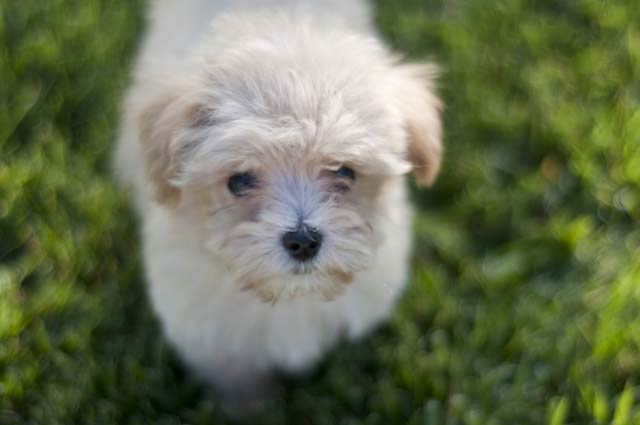
What If My Maltipoo Is Not The Right Weight?
If you’ve consulted a weight chart or observed your dog’s physical appearance and felt their ribs, and you believe that your Maltipoo is not the right weight, you could do the following:
Schedule their meals properly
One common mistake of pet owners is not scheduling their dog’s meal properly, which leads to your pet being either under or overfed. It is important to set a schedule on when your Maltipoo will eat so that they won’t tend to gobble too much food.
If you keep their meals at suitable intervals, their bodies will adjust accordingly and they will only get hungry when it’s near their mealtime, causing their digestive system to be regularized. This scheduling habit will ensure a healthy weight for your dog.
For those who are often outside their home, if you can’t have someone to tend to the dog’s meals throughout the day, some automatic feeders will dispense food to your dog at certain times of the day. Some of them are even equipped with IP cameras to help you communicate with your dog.
Consult your vet for a proper meal plan
If you aren’t sure what to feed your Maltipoo to ensure that they get the right weight, why not consult your vet? They might give you a proper meal plan that will consist of quality nutrients, vitamins, and a balance of everything that your dog needs to maintain a healthy weight.
Some vets recommend raw feeding and home-cooked meals. However, if you don’t have the time to do that, you can also ask about recommended commercial food that’s suitable for your Maltipoo – different foods are formulated for different breed sizes, diet plans, and health concerns.
Avoid foods with little nutrients
Most pet owners and vets will tell you to avoid foods that are heavy on fillers such as corn and wheat since they aren’t easily digestible by your dog. Instead, you can opt for foods with a more balanced set of ingredients, such as chicken, lamb, venison, fish, and a dash of vegetables and/or fruits.
Sure, commercial foods might be cheaper in the long run. However, if your dog gets sick due to excessively feeding them with low-quality cheap commercial foods, you will need to spend more on vet bills and medicine, anyway.
Know how active your dog is
Is your dog frequently running around all day or do they just lounge at home? Your Maltipoo’s activity levels dictate how much you should feed them. Dogs that don’t do a lot every single day shouldn’t be fed with too many calories because that would only lead to obesity.
Check their genetic information
Some breeders will also give you information about the history of obesity and other weight-related problems of your Maltipoo. If you don’t have much information, it’s best to ask your vet about it. Not all dogs are built the same when it comes to metabolism, after all.
Add some veggies and fruits
Certain vegetables and fruits will help your Maltipoo to retain a healthy weight. Veggies are typically low on calories so they will work well as part of your Maltipoo’s daily meals. They also provide some nutrients, vitamins, and minerals to make your dog healthy.
How to Help a Maltipoo Lose Weight
If you’ve observed and concluded that your Maltipoo is overweight, don’t worry – there are many ways to help them lose weight healthily:
Manage their calorie intake
You don’t necessarily have to lessen the food amount given to your Maltipoo. All you need is to replace high-calorie foods with low-calorie ones. When choosing commercial dog food, look for the calorie count and compare it with other brands.
Stick to your feeding plan
Don’t let your dog wander off being free-fed or consuming too many snacks in a day. We recommend keeping track of your Maltipoo’s daily meals using a chart. If you can’t be there all day for your dog, consider using an automatic feeding dispenser.
Don’t try to rush the diet
Never be in a hurry to make your Maltipoo lose weight. Keep the weight goal achievable and realistic as much as possible. At least a percent of body weight per week can be lost and that’s fine – any progress is still progress.
Exercise smartly
As with food changes, don’t be in a rush to hurriedly make your Maltipoo do vigorous exercise to lose weight. Instead, slowly introduce them to physical activity such as walks in the park or simply going around the yard. Just add a few more minutes or difficulty as time goes by.
How Much Does It Cost To Own A Maltipoo?
Maltipoos vary in range depending on various factors, such as their size, and whether you’ll get them from a shelter or a breeder. The typical price range of a Maltipoo can be around $600 but even more expensive Maltipoos, such as the teacup variation, will be pricey – at around $4,000.
Maltipoos are considered luxury or designer dogs due to being a crossbreed. Smaller Maltipoos are pricier since they are more difficult to breed. Much rarer variations and colors of Maltipoos can also mean a higher price.
Q&A
A Maltipoo can live from 10 to 15 years depending on a variety of factors, such as their diet, genetics, physical fitness, living conditions, and more. If you are lucky and if you’ve taken care of your dog properly, your Maltipoo could even reach 17 years of age!
A Maltipoo needs to be taken to the grooming salon every 3 to 4 months for a trim. The haircut will depend on your preferences and the weather.
At 4 months old, a Maltipoo can get pregnant but we recommend getting them bred when they are around 9 to 12 months old. Reaching adulthood first before breeding your Maltipoo will result in much healthier puppies.
A Maltipoo litter can be around 4 to 6 puppies but it depends on the health of the dog. Successive pregnancies might increase the puppy count.
Consider looking for a 6- to 9-inch size if you want to give your Maltipoo a collar of any color. Make sure it is not too loose or too tight.
If you need to put your Maltipoo in a crate, it should have a 30-inch size, regardless of whether they are still puppies or adults. If you don’t have room, however, 19-inch crates will work just fine, but they should move to a bigger crate later on.
Maltipoos weigh 5 to 20 pounds so you can get either an 18- or 24-inch dog bed for them. Dog bed sizing depends on how big or small your Maltipoo is – mini, tiny, and teacup variations all differ in height and weight, after all.
